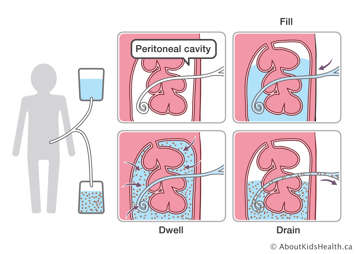Peritoneal dialysis (PD) is a type of dialysis that occurs inside the body. It uses the peritoneal membrane, a thin lining around the abdomen (tummy), to filter the blood. The lining is semi-permeable, meaning that it allows some small particles to pass through it. In this way, it removes waste products and unwanted fluid from the blood.
Before your child can start peritoneal dialysis, they will have surgery (an operation) to insert a peritoneal dialysis catheter, or tube, into the space inside the peritoneal membrane. This space is called the peritoneal cavity.
Benefits of peritoneal dialysis
Peritoneal dialysis is a gentle type of dialysis that can be done safely at home. It is simple to learn and is supported in most communities.
In particular, peritoneal dialysis:
- offers independence and control over your child's health care, as you perform the therapy
- allows more flexibility to work around your child's daily routine and any hobbies or family time
- is done through a portable machine that can be used inside or outside the home, for example on vacation (once there is a power outlet nearby)
- allows your child to eat and drink a wider range of food than if they were on in-hospital hemodialysis
- requires fewer trips to the hospital, which minimizes travel time and any transportation costs
- allows your child to attend school more often than if they were receiving in-hospital hemodialysis
- can be done on children of all ages, including babies
- helps your child feel more secure during treatment
What happens during peritoneal dialysis?
Your child will usually be offered automated peritoneal dialysis (APD). This uses a machine called a cycler, which automatically starts the dialysis.
Automated peritoneal dialysis involves three main phases:
- fill
- dwell
- drain
Fill
The peritoneal dialysis catheter fills the peritoneal cavity with a sterile dialysis solution called dialysate. This solution contains glucose (sugar).
Dwell
The solution stays in the peritoneal cavity for a short time.
Drain
Any waste products and unwanted fluid from the blood are filtered across the peritoneal membrane into the dialysis solution. The wastes and fluids then drain from the abdomen.

How peritoneal dialysis works
Like hemodialysis, peritoneal dialysis works on two principles:
- osmosis
- diffusion
Osmosis is the ability of water to pass through the wall of the semi-permeable membrane. The higher the concentration of glucose in the dialysis solution, the greater the amount of fluid that will move through the membrane.
Diffusion is the natural movement of particles from an area with many particles to an area with fewer particles. During peritoneal dialysis, waste products, which are highly concentrated in the blood, will filter across the peritoneal membrane into the dialysis solution, an area with no waste products.
Are all homes suitable for peritoneal dialysis?
Before you can start this dialysis, someone will visit you or ask you questions to check if your home is suitable for storing and using the dialysis equipment and supplies.
If it is suitable, a small, portable machine and all the supplies you need will be delivered to your home. Your provincial health plan will cover the costs.
Things to consider when deciding about peritoneal dialysis
To help you decide if peritoneal dialysis (PD) is suitable for your child, please consider the following points.
Your child's suitability for peritoneal dialysis
- Your child must have a healthy abdominal wall. PD cannot be done if any defects have been diagnosed.
Your ability and time to perform peritoneal dialysis
- As a caregiver, you must be able to understand and read English.
- You must be physically able to perform the therapy. This includes having the fine motor skills (for example, being able to control the small muscles in your hands) to safely operate the equipment and handle the tubing.
- You and your child (if they are old enough) must attend and complete training.
- You and your child must attend the peritoneal dialysis clinic every month or as needed.
- You must stick to the treatment plan and be flexible to deal with any health-care issues that occur.
- You will need to be committed to dialysis long-term, actively involved in decisions about your child's health and able to solve problems as they happen.
- You will need to have a reliable back-up person to help with dialysis if you are not available.
Your home's suitability for peritoneal dialysis
- Your home must be suitable for storing and using the equipment and supplies.
How peritoneal dialysis is done at home
Peritoneal dialysis can be done safely and easily in the home. You and your child will be supported and guided by the home dialysis team.
Most peritoneal dialysis treatments will happen at night while your child is sleeping. The three phases of fill, dwell and drain continue through the night based on the dialysis instructions that are programmed into the cycler.